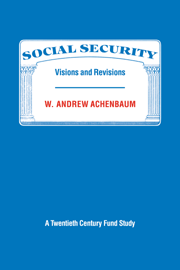Book contents
- Frontmatter
- Contents
- Dedication
- Foreword
- Acknowledgments
- Introduction
- Part I Social security comes of age
- 1 Social security: the early years
- 2 Social security matures, 1940–1972
- 3 The mid-life crisis of American social security
- 4 Social security gets a new lease on life
- Part II Current social security issues in historical perspective
- Notes
- Index
2 - Social security matures, 1940–1972
Published online by Cambridge University Press: 04 August 2010
- Frontmatter
- Contents
- Dedication
- Foreword
- Acknowledgments
- Introduction
- Part I Social security comes of age
- 1 Social security: the early years
- 2 Social security matures, 1940–1972
- 3 The mid-life crisis of American social security
- 4 Social security gets a new lease on life
- Part II Current social security issues in historical perspective
- Notes
- Index
Summary
Even without the legislative changes of 1939 the social security system would have grown. Simply because of the passage of time, more and more workers paid enough into the program to claim retirement benefits. When the 1939 amendments were enacted, 43.6 percent of the civilian labor force contributed to the system. Ten years later the figure had risen to 56.7 percent; 48.3 million wage and salary workers reported taxable earnings in 1950. The number of beneficiaries also increased, of course, but the number of contributors grew far more rapidly. Because start-up costs were low and tax rates remained modest, the system actually operated with a surplus during the period.
Although social security was growing as anticipated, those who were committed to social insurance knew the system was still quite vulnerable. In internal memoranda and speeches to social welfare groups, members of the Social Security Board acknowledged that the program's slow but steady growth would not be enough to protect it from attack. Political and economic changes, moreover, often upset policymakers' plans for social security. In the midst of World War II, for instance, the formula for old-age insurance benefits was frozen; proposals to liberalize the program were rejected. Because most analysts expected the United States to lapse into the same kind of economic slowdown that had followed World War I, conservative politicians were able to reject the passage of costly new provisions; a Republican-dominated Congress, supported by Southern Democrats, not only made Title II eligibility criteria for employee coverage more stringent but also defeated bills to enact national health insurance.
- Type
- Chapter
- Information
- Social SecurityVisions and Revisions: A Twentieth Century Fund Study, pp. 38 - 60Publisher: Cambridge University PressPrint publication year: 1986



